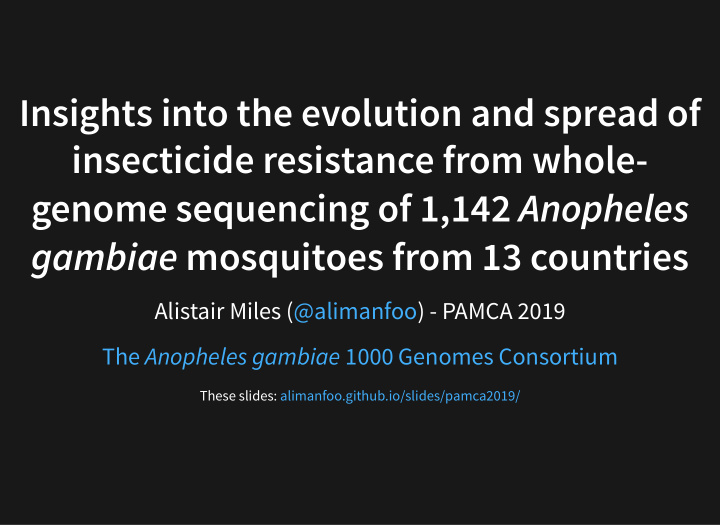



Insights into the evolution and spread of Insights into the evolution and spread of insecticide resistance from whole- insecticide resistance from whole- genome sequencing of 1,142 genome sequencing of 1,142 Anopheles Anopheles gambiae gambiae mosquitoes from 13 countries mosquitoes from 13 countries Alistair Miles ( @alimanfoo ) - PAMCA 2019 The Anopheles gambiae 1000 Genomes Consortium These slides: alimanfoo.github.io/slides/pamca2019/
Anopheles gambiae Anopheles gambiae 1000 Genomes 1000 Genomes Project - phase 2 Project - phase 2 N.B., one location per country; one time point per country; different countries sampled in different years; nothing more recent than 2012.
Methods Methods Collect mosquitoes Extract DNA Whole-genome sequencing (Illumina Hi-Seq) Align sequence reads Identify genetic differences
Single nucleotide polymorphisms (SNPs) Single nucleotide polymorphisms (SNPs) If a SNP occurs in a gene coding sequence, it may change the encoded amino acid sequence, which may change the behaviour of the protein.
Copy number variants (CNVs) Copy number variants (CNVs) If a CNV spans a gene, then the gene will occur twice (two copies) in the mutated genome. More gene copies may mean more protein is produced.
Ag1000G phase 2 data resource Ag1000G phase 2 data resource Across the whole genome, we find: 57,837,885 SNPs 31,335 CNVs
Outline Outline Pyrethroid resistance Metabolic resistance Target-site resistance Combined view Organophosphate resistance Emerging/unknown resistance Translation to surveillance
Pyrethroid metabolic resistance Pyrethroid metabolic resistance Pyrethroids are metabolised by cytochrome P450 (CYP) enzymes (a.k.a. mixed-function oxidases; MFOs) Increased expression of certain CYP genes causes resistance Genetic variants causing metabolic resistance not previously known in An. gambiae complex Although long suspected that CNVs play a role More gene copies → more protein → faster metabolism → resistance N.B., PBO LLINs work by inhibiting CYPs
CNV hot spots CNV hot spots Genome locations where we find a lot of CNVs at high population frequency: CYP6P/AA (cytochrome P450 gene cluster) CYP9K1 (cytochrome P450 gene) GSTE (glutathione S-transferase gene)
CNVs at CYP6P/AA CNVs at CYP6P/AA
CNVs at CYP9K1 CNVs at CYP9K1
Prevalence and spread of CYP6P/AA CNVs Prevalence and spread of CYP6P/AA CNVs Dup1 - An. gambiae : Uganda (58%) Dup7 - An. coluzzii : Burkina Faso (44%), Cote d'Ivoire (32%), Ghana (5%), Guinea (75%) Dup10 - An. coluzzii : Burkina Faso (49%), Ghana (5%) Dup11 - An. coluzzii : Burkina Faso (41%), Ghana (5%) Dup14 - An. coluzzii : Burkina Faso (3%), Cote d'Ivoire (46%) Dup15 - An. coluzzii : Burkina Faso (1%), Cote d'Ivoire (39%) Some CNVs are very common and spreading, especially in West African An. coluzzii .
Surveillance of metabolic resistance Surveillance of metabolic resistance Next-generation LLINs: how many, what type, where to put them? Which populations have CYP-mediated metabolic resistance? CNVs are likely to be a good marker of CYP-mediated metabolic resistance Although, N.B., there could be other genetic variants causing metabolic resistance
See also "Insecticide resistance gene copy number variation in malaria mosquitoes" on
Pyrethroid target-site resistance Pyrethroid target-site resistance Pyrethroids bind to the voltage-gated sodium channel (VGSC) protein SNPs in the VGSC gene can change the protein and cause resistance Known resistance SNPs L995F (" kdr west") L995S (" kdr east") L995F + N1570Y
Prevalence of Prevalence of kdr kdr L995F L995F An. gambiae : Cameroon (53%), Ghana (100%), Burkina Faso (100%), Guinea (100%), Gabon (33%) An. coluzzii : Angola (84%), Ghana (82%), Burkina Faso (85%), Cote d'Ivoire (91%), Guinea (88%)
Prevalence of Prevalence of kdr kdr L995S L995S An. gambiae : Cameroon (16%), Gabon (67%), Uganda (100%), Kenya (76%)
Prevalence of Prevalence of kdr kdr L995F + N1570Y L995F + N1570Y An. gambiae : Cameroon (6%), Ghana (17%), Burkina Faso (21%), Guinea (9%) An. coluzzii : Burkina Faso (27%)
New resistance SNPs? New resistance SNPs? L995F + R254K L995F + D466H + I1940T L995F + T791M + A1746S L995F + E1597G L995F + K1603T L995F + V1853I L995F + I1868T L995F + P1874S L995F + P1874L L995F + F1920S L995F + A1934V V402L + I1527T There is much more to pyrethroid target-site resistance than just kdr !
Spread of target-site resistance Spread of target-site resistance Use genetic backgrounds (haplotypes) to infer outbreaks of resistance. E.g., "F1" is a major outbreak driven by kdr L995F, has spread throughout West and Central Africa, and spread between An. gambiae and An. coluzzii .
(Will be updated with new data from Ag1000G phase 2 soon.)
Pyrethroid resistance mechanisms Pyrethroid resistance mechanisms Possible to combine data on target-site and metabolic resistance, to show which molecular mechanisms are present in which populations.
Organophosphate resistance Organophosphate resistance Organophosphates bind to acetylcholinesterase (ACE1) enzyme Genetic changes in ACE1 gene associated with resistance SNPs (G119S) and CNVs
Prevalence of ACE1 SNPs and CNVs Prevalence of ACE1 SNPs and CNVs G119S and CNV always found together. Spreading in West Africa, both An. gambiae and An. coluzzii .
Unknown/emerging resistance Unknown/emerging resistance mechanisms mechanisms GSTE CNVs - major role in metabolic resistance of pyrethroids? Carboxylesterases - role in organophosphate resistance? Emerging signals at other genes in acetylcholine regulation pathway?
Translation to surveillance Translation to surveillance Use cases in insecticide resistance management Deployment of next-generation LLINs Rotation of next-generation IRS Need recent samples Need better geographical coverage Need more species (e.g., An. arabiensis , An. funestus ) Scale up whole-genome sequencing at genome centres N.B., Wellcome Sanger Institute can now sequence 10,000 mosquitoes/year Scale up targeted (amplicon) sequencing at local/region labs
Acknowledgments Acknowledgments This work was carried out by the Anopheles gambiae 1000 Genomes Consortium: Thank you to the staff of the Wellcome Sanger Institute Sample Logistics, Sequencing and Informatics facilities. Thank you to Wellcome Trust, MRC UK, DFID UK, NIH, NIAID, Bill and Melinda Gates Foundation.
Extra slides Extra slides
Recommend
More recommend